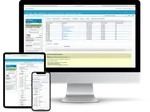
Former Executive/Clinical Director & Forensic Interviewer Ted Buckenham Joins Collaborate Team
We’re always looking for new ways to bolster the Collaborate team and better serve our clients. When Ted Buckenham - a former Executive Director for Paulding Child Advocacy Center and seasoned Collaborate user - expressed interest in working with us as a training specialist, we jumped at the chance.

We sat down with Ted recently to ask about his his experience in the CAC world, his decision to join the team, and what he likes to do when he isn’t training organizations on how to get the most out of Collaborate.
Welcome aboard, Ted! Can you give us a brief history of your experience working with CACs?
I started as an intern with a CAC in Georgia when I was a freshman in college. I truly loved the work, and was fascinated by how the forensic interview was able to gather information from children in a way that was not traumatizing.
Seeing how the CAC model helped children and families recover from their experiences, I knew pretty quickly that it was the career path for me. I wore many hats over the years between conducting forensic interviews, crisis counseling for families, and - on the other end of the CAC spectrum - raking leaves out in front of our center. One time [laughs] I even extricated a possum from the crawl space underneath our building!
Obviously you picked up many different skills over the years. When did you start using Collaborate, and how did you contribute to the software’s evolution?
In the mid-2000s, the state network of CACs for Georgia, CACGA, was looking for a CAC case management system that could be used by all its member centers. I had earned the nickname “Wires” because I loved electronics, and became the de facto tech guy around the office.
I was asked to lead up the team that eventually decided to go with the predecessor to Collaborate, and spec it out for our custom implementation. We were the first-ever statewide CAC network to adopt the software.
Ted Buckenham by the Numbers
Years in a CAC setting
Forensic interviews conducted
Hours in Collaborate as a user and trainer
Collaborate users he’ll be impacting in 2019
I remember we came up with the concept of Service mapping, and Network Ninja engineers figured out how to integrate it into Collaborate. That was one of our biggest contributions to the platform. We also helped build upon the system’s Relationships backbone - for example, a Client can have an Associated Person with a Relationship of “Mother” or “Sister,” and those Associated Persons have other Relationships in the database.
This sounds pretty simple at first, but when you consider that Collaborate figures a lot of this out automatically for you, even for complex family structures - and makes these things accurately reportable - it’s really awesome.

What made you want to shift gears and train organizations to use Collaborate full time?
I really enjoyed working with the families we served in Georgia and with our partner agencies, but after over 20 years of being “in the trenches,” I started to think maybe it was time for a change of scenery. At the same time, I didn’t want to completely leave the CAC world.
I had assisted CACGA and Network Ninja in conducting several Collaborate trainings across Georgia, and liked helping other CAC staff learn the system. The idea of doing this full-time dawned on me at that point, and I approached Network Ninja about the possibility of coming on board.
Since you’ve actually lived through this process, how can better case management help social services organizations achieve their goals?
Social services agencies are chronically understaffed. Better case management software helps their workers get the “deskwork” portion of their jobs done quicker so they can spend more time doing what they’re there for: assisting families.
There are many things in Collaborate that streamline your workflow. Sometimes it’s so fast and easy you don’t even realize how many steps were saved by what the system figures out for you.
Agencies can also use the software to track statistical data so they can report those numbers to grant funders. The ease of entering the information into Collaborate reduces the chances of user error, so the right information is there when you or others need it. Accurate information also helps make sure families get the services they need, and most importantly, helps prevent families from “falling through the cracks.”
You recently traveled to Huntsville, Alabama to train National Children’s Advocacy Center staff on their new Collaborate implementation. What was that like?
I had been to NCAC several times before, so it was almost like coming back home. It was great to see so many people I’d worked with in the past, and I was proud of the opportunity to train them.

They’re a great group to work with, as anybody will tell you. While I was there I really didn’t feel like I was from an “outside agency.” I felt more like a representative from a partner agency, and we had all come together for a common goal. We are helping them help families.
When you aren’t facilitating custom Intakes or pulling Reports for funders, what do you like to do for fun?
I really enjoy spending time with my wife and kids. We’ll load up the car and go on some random surprise adventure on a Saturday - spend the day at a national park, hike in the woods, or rent a boat at a nearby lake. The kids love the surprise (sometimes I won’t tell them where we’re going and they try to guess as we drive to the destination, giving them clues along the way).

I also enjoy photography as a hobby. Camera equipment isn’t cheap, so to help fund it I do family portraits and youth sports photos.
Thanks for your time, Ted! We know you’ll be delighted to help so many clients get the most out of Collaborate.
It’s an honor to be a part of this team. I’ll admit that I was nervous when I first made the decision, but within a short time with the people here, I knew I’d made the right choice. I’m excited to leverage my years of experience to train Collaborate users, and to help augment the software as well!
Chris Newlin, Executive Director of National Children’s Advocacy Center, had some thoughts on Ted’s new role:
Ted is an innovator and always seeking to improve what we do for kids, and this includes using technology to facilitate our work. It is funny Ted mentions the nickname “Wires”. He was a new employee when we gave him that nickname at Harbor House because it seemed he could do anything that involved wires.
In 2001 we decided to network our computers at Harbor House, and Ted convinced me to run all of the CAT5 line in the same crawl space where he retrieved the possum, while he enjoyed the comfort of connecting these cables inside the air-conditioned CAC. It is amazing to see how far we have come with technology, and “Wires” continues to advocate for kids in this new role!

